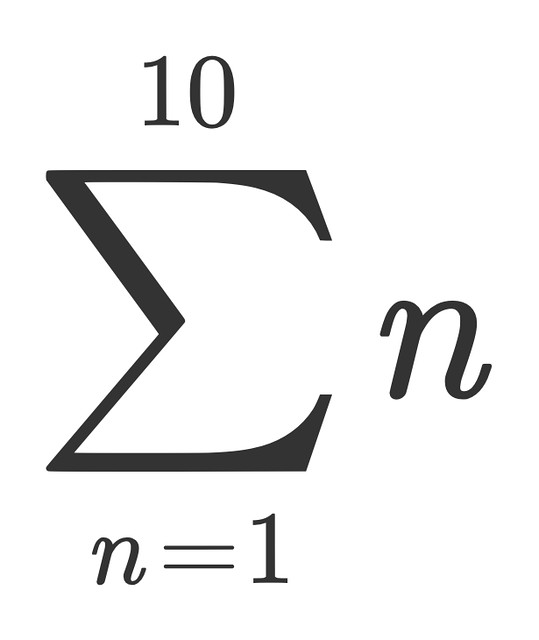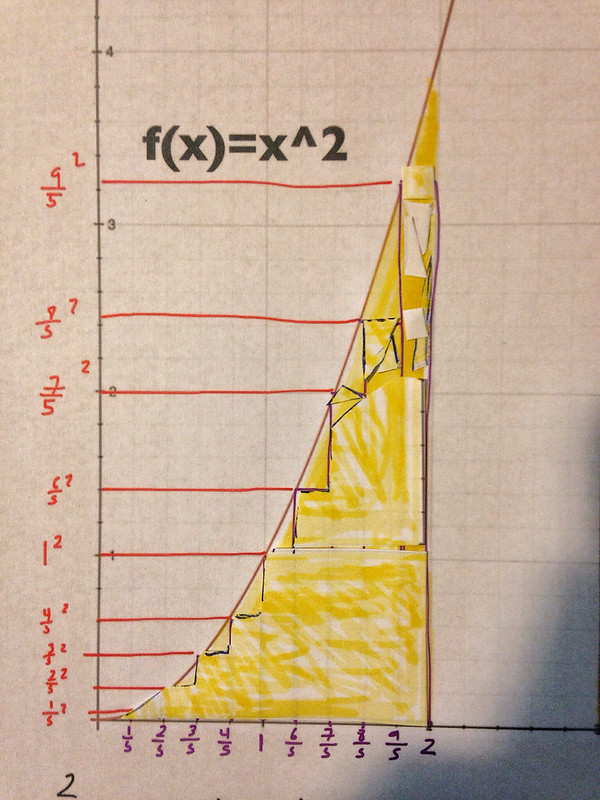I wish I could explain how satisfying it is to finally learn the concepts of integration in calculus. For years I have seen how people would represent calculus with a picture of a curved function with the area under it shaded, and for the life of me, I could not figure out how they would calculate that. Now I know. The relative simplicity of the process has a ring of truth, and symmetry, and beauty that threw me back to discovering geometrical theorems in high school.
Well, here it goes: Integrals as I understood them.
Imagine you have a formula that is continuous at least for a given interval [a,b]. I chose again x2 in the closed interval form 1 to 2. I already tried to find the area under that curve in my post on Sigma.
By using 10 rectangles of width 1/5 and height x2, I was able to approximate the area under the curve to be 2.28 square units an underestimation of the true area. However, I posted that I could get better approximations if my rectangles had been infinitely small.
To get those better approximations I need to improve the sum I used before, pictured to the right. And in order to do that, I would need to convert it into a Riemman Sum.
The toughest part of doing integration is to set up the correct Riemman Sum for the purposes intended. I struggled so hard with this part that I want to give you this video to follow just in case I mess up. Here is the general formula for a Riemman Sum:
Since I am doing a right Riemman Sum, I will use this version of the formula. Where a and b are the interval of my function, and n represents the times I will be cutting that interview. A right Riemman sum will give me an overestimate of the area under the curve, which will complement the underestimate of 2.28 I got
The first thing you need to do to set up a Riemman sum is deciding what your interval is (in this case is from 0 to 2) and then decide how wide you want your divisions within that interval to be. I want my intervals to be 1/5 units wide, but that is not important right now, just remember there are ten 1/5 divisions from the interval 0 to 2. Then for the height of my rectangles I chose to evaluate the function x2 on the right hand side of those intervals. With those steps selected then I follow the x2 rules for Riemman Sums.
A Riemman Sum is the addition of the formula I want to evaluate (x2) at the specific cuts I made. The first point on my interval is a=0 and the last point is b=2. I want to divide that interval in n cuts of a certain size. The formula for the cut size is:
Now here is the formula for the height of my rectangles.
So putting all the steps together here is the formula for my Riemman Sum
And that is actually the hard part, for me at least. The rest is arithmetic.
So the answer I got was: 8/3 + 4/n + 4/3n2
But what does that mean? Remember when I said I wanted the width of my rectangles to be 1/5 units and that it meant I would get 10 segments from interval 0 to 2? Well, if you substitute n=10. The area under the curve it gives me is 3.08 square units.
Now since this is a right Riemman sum I know it is an overestimate. My last attempt in the Sigma post was equivalent to a left Riemman sum which gave me an underestimate of 2.28.
If I take the average of these two numbers I should be able to get a better estimate of the area under the curve: (3.08 + 2.28)/2 = 2.68.
And 2.68 is very close to the true area under the curve which is approximately 2.667. Now, how can we get there?
Well supposed that instead of splitting my interval of this Riemman sum into 10 pieces I split it into 100, n=100, what happens then? We get 2.708 instead of 3.08. And what if n=10,000, that would make our rectangles very, very small, we then get 2.670! That is very, very close to 2.667
And what if n=infinity?
Then the n in this formula 8/3 + 4/n + 4/3n2 would be so small (and therefore the width of the rectangles would be also so small) that the only effect relevant in 8/3, and guess what 8/3 comes down to: 2.667 approximately.
And what did we just do? We just took a limit.
Whoah! What?!!
Yes, we took the limit of our formula to get the true area under the curve. And that my friends is called integration.
To integrate is to do the following:
To take the limit of the Riemman Sum you are working on as n approaches infinity.
In fact the definite integral is a normally written as a variation of the formula above.
The elongated S just means, take the limit of the sum of f(x) times the change of x from the interval from a to be, as that change of x gets infinetly small.
And there you have it. Integration via the sum of infinite rectangles.
This one was a tough one and there are some considerations to this integrations stuff, but you can review them here.
Let me know what you think in the comments.

























